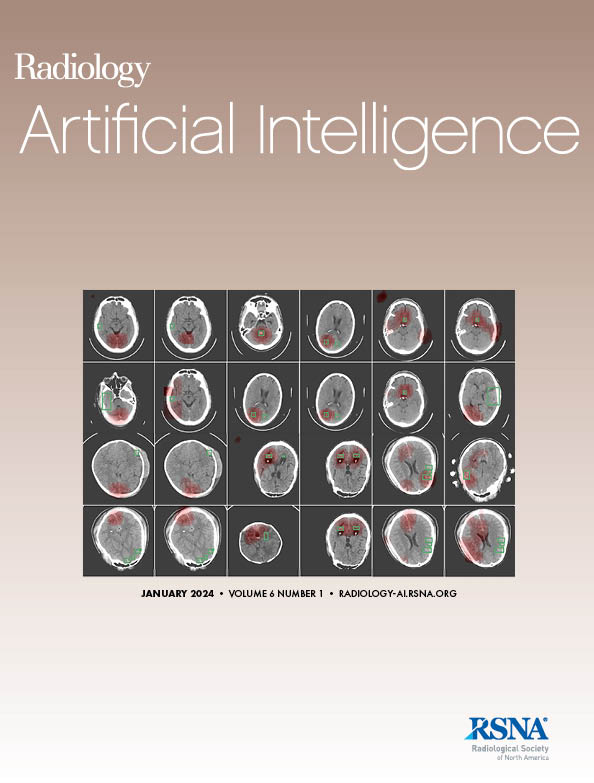Performance of Lung Cancer Prediction Models for Screening-detected, Incidental, and Biopsied Pulmonary Nodules.
IF 13.2
Q1 COMPUTER SCIENCE, ARTIFICIAL INTELLIGENCE
Thomas Z Li, Kaiwen Xu, Aravind Krishnan, Riqiang Gao, Michael N Kammer, Sanja Antic, David Xiao, Michael Knight, Yency Martinez, Rafael Paez, Robert J Lentz, Stephen Deppen, Eric L Grogan, Thomas A Lasko, Kim L Sandler, Fabien Maldonado, Bennett A Landman
下载PDF
{"title":"Performance of Lung Cancer Prediction Models for Screening-detected, Incidental, and Biopsied Pulmonary Nodules.","authors":"Thomas Z Li, Kaiwen Xu, Aravind Krishnan, Riqiang Gao, Michael N Kammer, Sanja Antic, David Xiao, Michael Knight, Yency Martinez, Rafael Paez, Robert J Lentz, Stephen Deppen, Eric L Grogan, Thomas A Lasko, Kim L Sandler, Fabien Maldonado, Bennett A Landman","doi":"10.1148/ryai.230506","DOIUrl":null,"url":null,"abstract":"<p><p>Purpose To evaluate the performance of eight lung cancer prediction models on patient cohorts with screening-detected, incidentally detected, and bronchoscopically biopsied pulmonary nodules. Materials and Methods This study retrospectively evaluated promising predictive models for lung cancer prediction in three clinical settings: lung cancer screening with low-dose CT, incidentally detected pulmonary nodules, and nodules deemed suspicious enough to warrant a biopsy. The area under the receiver operating characteristic curve of eight validated models, including logistic regressions on clinical variables and radiologist nodule characterizations, artificial intelligence (AI) on chest CT scans, longitudinal imaging AI, and multimodal approaches for prediction of lung cancer risk was assessed in nine cohorts (<i>n</i> = 898, 896, 882, 219, 364, 117, 131, 115, 373) from multiple institutions. Each model was implemented from their published literature, and each cohort was curated from primary data sources collected over periods from 2002 to 2021. Results No single predictive model emerged as the highest-performing model across all cohorts, but certain models performed better in specific clinical contexts. Single-time-point chest CT AI performed well for screening-detected nodules but did not generalize well to other clinical settings. Longitudinal imaging and multimodal models demonstrated comparatively good performance on incidentally detected nodules. When applied to biopsied nodules, all models showed low performance. Conclusion Eight lung cancer prediction models failed to generalize well across clinical settings and sites outside of their training distributions. <b>Keywords:</b> Diagnosis, Classification, Application Domain, Lung <i>Supplemental material is available for this article.</i> © RSNA, 2025 See also commentary by Shao and Niu in this issue.</p>","PeriodicalId":29787,"journal":{"name":"Radiology-Artificial Intelligence","volume":" ","pages":"e230506"},"PeriodicalIF":13.2000,"publicationDate":"2025-03-01","publicationTypes":"Journal Article","fieldsOfStudy":null,"isOpenAccess":false,"openAccessPdf":"https://www.ncbi.nlm.nih.gov/pmc/articles/PMC11950892/pdf/","citationCount":"0","resultStr":null,"platform":"Semanticscholar","paperid":null,"PeriodicalName":"Radiology-Artificial Intelligence","FirstCategoryId":"1085","ListUrlMain":"https://doi.org/10.1148/ryai.230506","RegionNum":0,"RegionCategory":null,"ArticlePicture":[],"TitleCN":null,"AbstractTextCN":null,"PMCID":null,"EPubDate":"","PubModel":"","JCR":"Q1","JCRName":"COMPUTER SCIENCE, ARTIFICIAL INTELLIGENCE","Score":null,"Total":0}
引用次数: 0
引用
批量引用
Abstract
Purpose To evaluate the performance of eight lung cancer prediction models on patient cohorts with screening-detected, incidentally detected, and bronchoscopically biopsied pulmonary nodules. Materials and Methods This study retrospectively evaluated promising predictive models for lung cancer prediction in three clinical settings: lung cancer screening with low-dose CT, incidentally detected pulmonary nodules, and nodules deemed suspicious enough to warrant a biopsy. The area under the receiver operating characteristic curve of eight validated models, including logistic regressions on clinical variables and radiologist nodule characterizations, artificial intelligence (AI) on chest CT scans, longitudinal imaging AI, and multimodal approaches for prediction of lung cancer risk was assessed in nine cohorts (n = 898, 896, 882, 219, 364, 117, 131, 115, 373) from multiple institutions. Each model was implemented from their published literature, and each cohort was curated from primary data sources collected over periods from 2002 to 2021. Results No single predictive model emerged as the highest-performing model across all cohorts, but certain models performed better in specific clinical contexts. Single-time-point chest CT AI performed well for screening-detected nodules but did not generalize well to other clinical settings. Longitudinal imaging and multimodal models demonstrated comparatively good performance on incidentally detected nodules. When applied to biopsied nodules, all models showed low performance. Conclusion Eight lung cancer prediction models failed to generalize well across clinical settings and sites outside of their training distributions. Keywords: Diagnosis, Classification, Application Domain, Lung Supplemental material is available for this article. © RSNA, 2025 See also commentary by Shao and Niu in this issue.
肺癌预测模型在筛查发现的肺结节、偶然发现的肺结节和活检肺结节中的表现。
"刚刚接受 "的论文经过同行评审,已被接受在《放射学》上发表:人工智能》上发表。这篇文章在以最终版本发表之前,还将经过校对、排版和校对审核。请注意,在制作最终校对稿的过程中,可能会发现一些错误,从而影响文章内容。目的 评估八个肺癌预测模型在筛查发现的、偶然发现的和支气管镜活检发现的肺结节患者队列中的表现。材料与方法 本研究回顾性地评估了三种临床环境下肺癌预测模型的预测效果:使用低剂量 CT 进行肺癌筛查、偶然检测到肺结节以及被认为可疑到需要进行活检的结节。在来自多个机构的 9 个队列(n = 898、896、882、219、364、117、131、115、373)中评估了 8 个经过验证的模型的接收器工作特征曲线下面积(AUC),这些模型包括临床变量和放射科医生结节特征的逻辑回归、胸部 CT 人工智能(AI)、纵向成像人工智能以及预测肺癌风险的多模态方法。每个模型都是根据其发表的文献实施的,每个队列都是根据 2002 年至 2021 年期间收集的原始数据来源策划的。结果 在所有队列中,没有一个预测模型是表现最好的模型,但某些模型在特定的临床环境中表现更好。单个时间点胸部 CT AI 在筛查发现的结节方面表现良好,但在其他临床环境中表现不佳。纵向成像和多模态模型在偶然检测到的结节上表现相对较好。当应用于活检结节时,所有模型都表现出较低的性能。结论 八种肺癌预测模型未能在其训练分布以外的临床环境和部位中很好地推广。©RSNA, 2025.
本文章由计算机程序翻译,如有差异,请以英文原文为准。

 求助内容:
求助内容: 应助结果提醒方式:
应助结果提醒方式:


